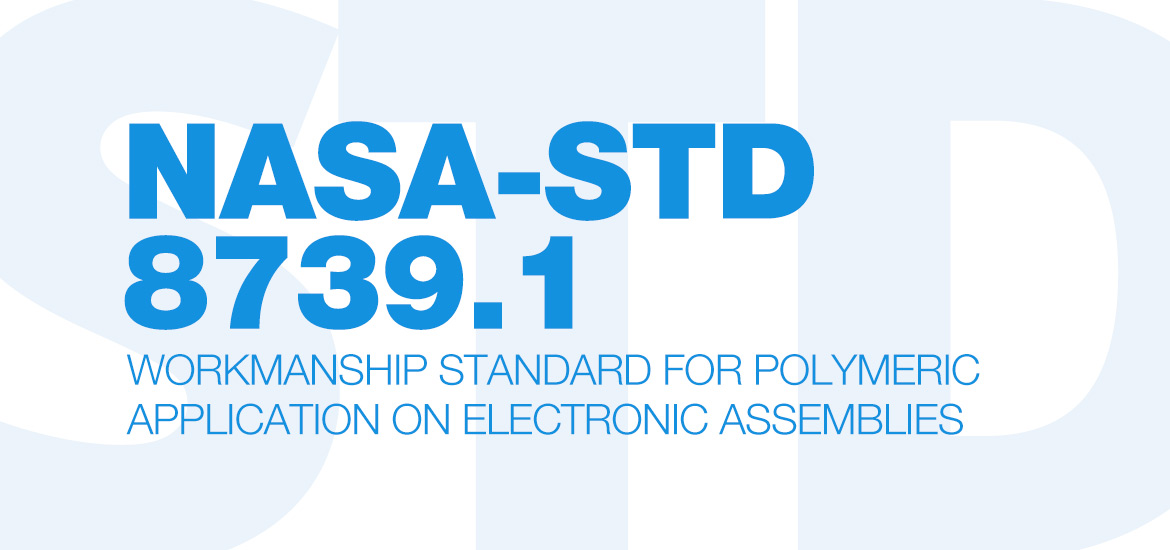Update to Polymeric Application Standard Published
August 25, 2016
3-minute read

Update: This article was updated to reflect that Alvin Boutte is now the Point of Contact for questions regarding Workmanship Standards.
NASA-STD-8739.1B, Workmanship Standard for Polymeric Application on Electronic Assemblies was updated and released on June 30, 2016. The revised standard, effective for five years, includes significant technical updates and corrections. This update was one of three recently publish standard updates, which included NASA-STD-8739.4A, Crimping, Interconnecting Cables, Harnesses, and Wiring and NASA-STD-8739.6A, Implementation Requirements for NASA Workmanship Standards.
The following is a brief summary of the changes, but to learn more, review the Document History Log in the front of the standard document:
- Requirements that were generic to all NASA Workmanship standards were moved to NASA-STD-8739.6, Implementation Requirements for NASA Workmanship Standards. Examples are requirements traceability in suppliers’ procedures, use of alternate standards, use of nonstandard configurations and laboratory environment conditions.
- Definitions found in NASA-STD-8709.22, Safety & Mission Assurance Acronyms, Abbreviations, & Definitions, were removed. The definitions for the terms “rework” and “repair” are now applicable. Additionally, definitions were added or improved for the following terms:
- Accelerator
- Bonding
- Catalyst
- Conformal coating test specimen
- Encapsulation
- Engineering documentation
- Glass transition and glass transition temperature high voltage
- Keep-out areas
- Noncommon conductors
- Part lead
- Pot life
- Solvent
- Specimen
- Materials mix test
- Staking
- Staking material
- Stress relief
- Test specimen
- Use of the IPC standard test method, TM-650, Test Method 2.6.9.2, “Test to Determine Sensitivity of Electronic Components to Ultrasonic Energy,” prior to use of ultrasonic cleaning methods is now required.
- Keep-out areas for staking and conformal coating must now be documented in engineering documentation (e.g., assembly drawings, assembly procedures). Layout designs must provide sufficient spacing or room to accommodate planned staking, and coating and staking in keep-out areas is now a defect.
- Inspection is no longer recognized as a viable means for evaluating effective stress relief in leads when staking or conformal coating contact or cover the leads. The design requirement remains to prevent intentional uses of staking and thick conformal coating that is not compatible with leads’ stress relief. Test or analysis is now required to accept assemblies where staking or conformal coating are nonconforming with the design intent.
- The supplier/designer is responsible for defining bond-line acceptance limits.
- The document scope with respect to bonding is clarified to limit it to Printed Wiring Assembly applications.
- A lack of bonding material under flanges of packages that employ fasteners is now considered a defect. This type of defect has been the root cause of high torques transferred to those flanges leading to cracks in the flanges.
- High-voltage assemblies must be identified as such in the engineering documentation.
- Underfill of area array solder joints and interconnects is considered a nonstandard configuration.
- Criteria was added for assuring successful use of polymers with expired shelf life dates.
- Process controls are required when baking out assemblies at temperatures of 100 degrees Celsius or hotter.
- New language and requirements for mix assurance now accommodate the widespread use of premixed and small batches of mixed polymer.
- Testing polymer mix quality in parallel with its use on mission hardware now requires prior approval.
- Sleeved and sleeveless axial leaded tantalum capacitors must be staked along the long package side. End staking, where the leads exit the package, is no longer required.
- Fastener staking shall be residue-free and removable.
- Requirements in Chapter 13 that were duplicates of those in prior chapters were removed.
Revising the Standard
Two-hundred and sixty comments were received for this revision of this standard. The acceptance rate for the comments that were received was 59 percent. Of the comments that were not accepted, 79 percent related to rewording or adding to language or requirements that were moved to NASA-STD-8739.6. Many of the other comments that were not accepted were more appropriate for inclusion in the training materials or the website as the information was out of scope. Similarly, some comments that were not accepted required or requested specific implementations of materials or processes with the unintended consequence of excluding other viable solutions.
Questions about the standard or suggestions for improvements may be addressed to Alvin Boutte.